CHERY TIGGO 2009 Service Repair Manual
Manufacturer: CHERY, Model Year: 2009, Model line: TIGGO, Model: CHERY TIGGO 2009Pages: 1903, PDF Size: 33.38 MB
Page 1511 of 1903
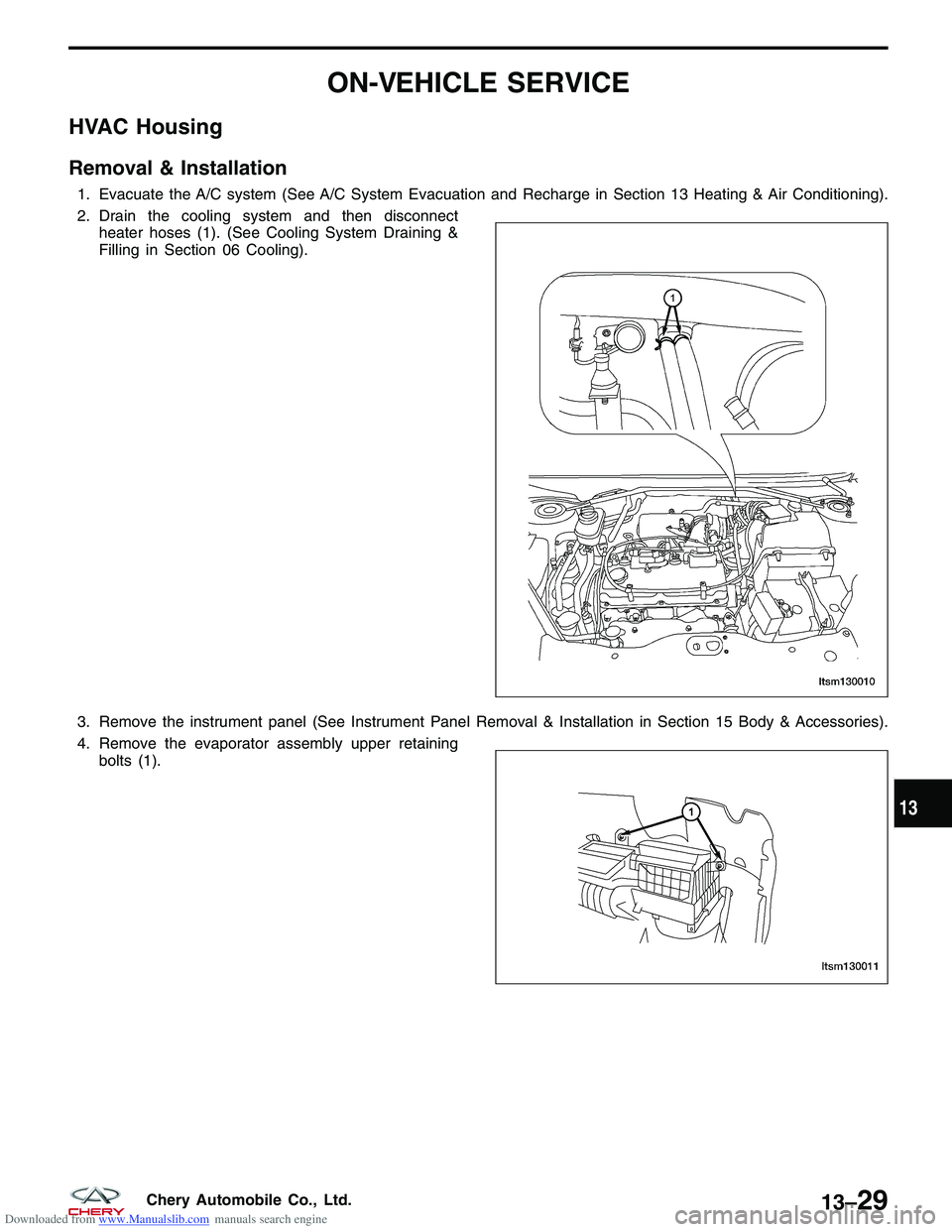
Downloaded from www.Manualslib.com manuals search engine ON-VEHICLE SERVICE
HVAC Housing
Removal & Installation
1. Evacuate the A/C system (See A/C System Evacuation and Recharge in Section 13 Heating & Air Conditioning).
2. Drain the cooling system and then disconnectheater hoses (1). (See Cooling System Draining &
Filling in Section 06 Cooling).
3. Remove the instrument panel (See Instrument Panel Removal & Installation in Section 15 Body & Accessories).
4. Remove the evaporator assembly upper retaining bolts (1).
LTSM130010
LTSM130011
13
13–29Chery Automobile Co., Ltd.
Page 1512 of 1903
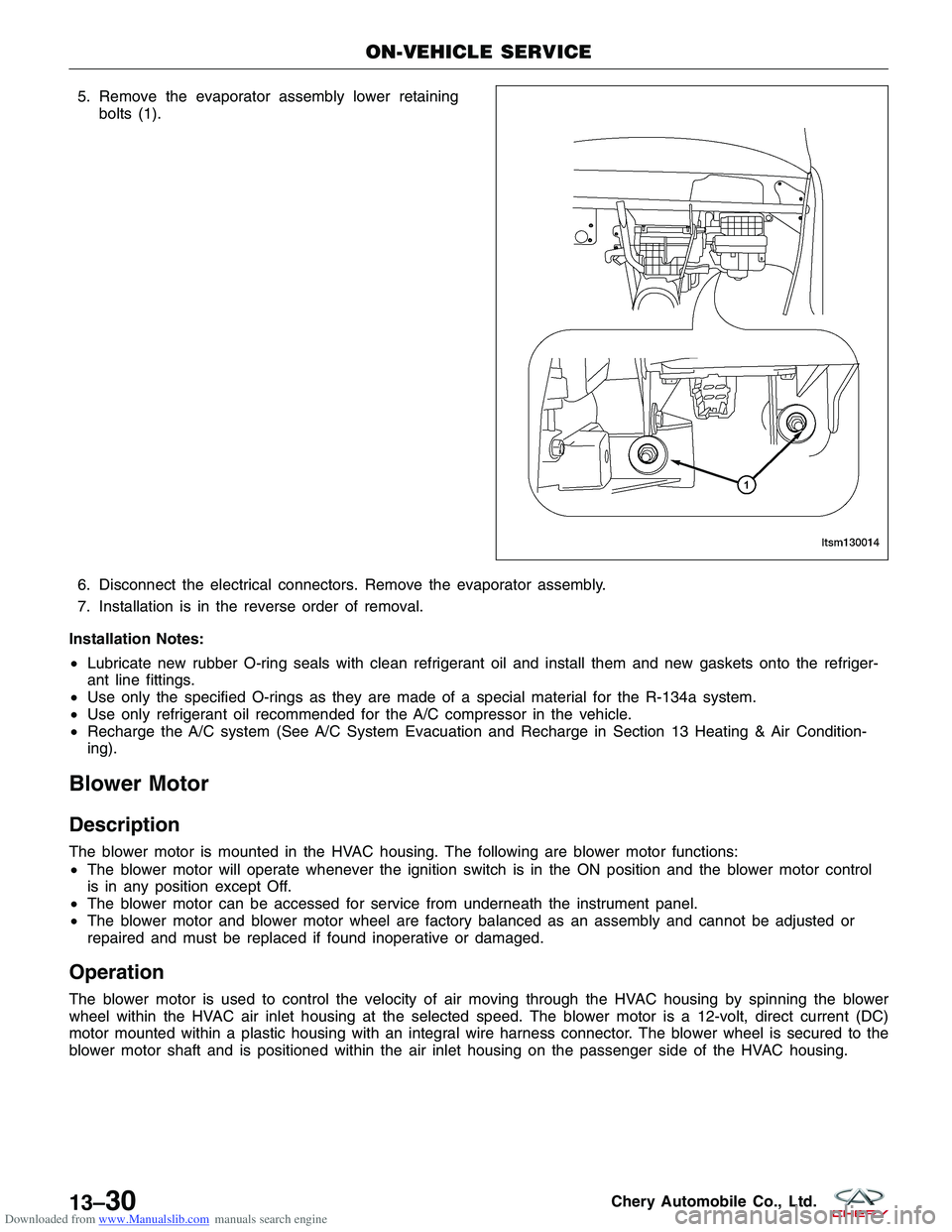
Downloaded from www.Manualslib.com manuals search engine 5. Remove the evaporator assembly lower retainingbolts (1).
6. Disconnect the electrical connectors. Remove the evaporator assembly.
7. Installation is in the reverse order of removal.
Installation Notes:
• Lubricate new rubber O-ring seals with clean refrigerant oil and install them and new gaskets onto the refriger-
ant line fittings.
• Use only the specified O-rings as they are made of a special material for the R-134a system.
• Use only refrigerant oil recommended for the A/C compressor in the vehicle.
• Recharge the A/C system (See A/C System Evacuation and Recharge in Section 13 Heating & Air Condition-
ing).
Blower Motor
Description
The blower motor is mounted in the HVAC housing. The following are blower motor functions:
•The blower motor will operate whenever the ignition switch is in the ON position and the blower motor control
is in any position except Off.
• The blower motor can be accessed for service from underneath the instrument panel.
• The blower motor and blower motor wheel are factory balanced as an assembly and cannot be adjusted or
repaired and must be replaced if found inoperative or damaged.
Operation
The blower motor is used to control the velocity of air moving through the HVAC housing by spinning the blower
wheel within the HVAC air inlet housing at the selected speed. The blower motor is a 12-volt, direct current (DC)
motor mounted within a plastic housing with an integral wire harness connector. The blower wheel is secured to the
blower motor shaft and is positioned within the air inlet housing on the passenger side of the HVAC housing.
ON-VEHICLE SERVICE
LTSM130014
13–30Chery Automobile Co., Ltd.
Page 1513 of 1903
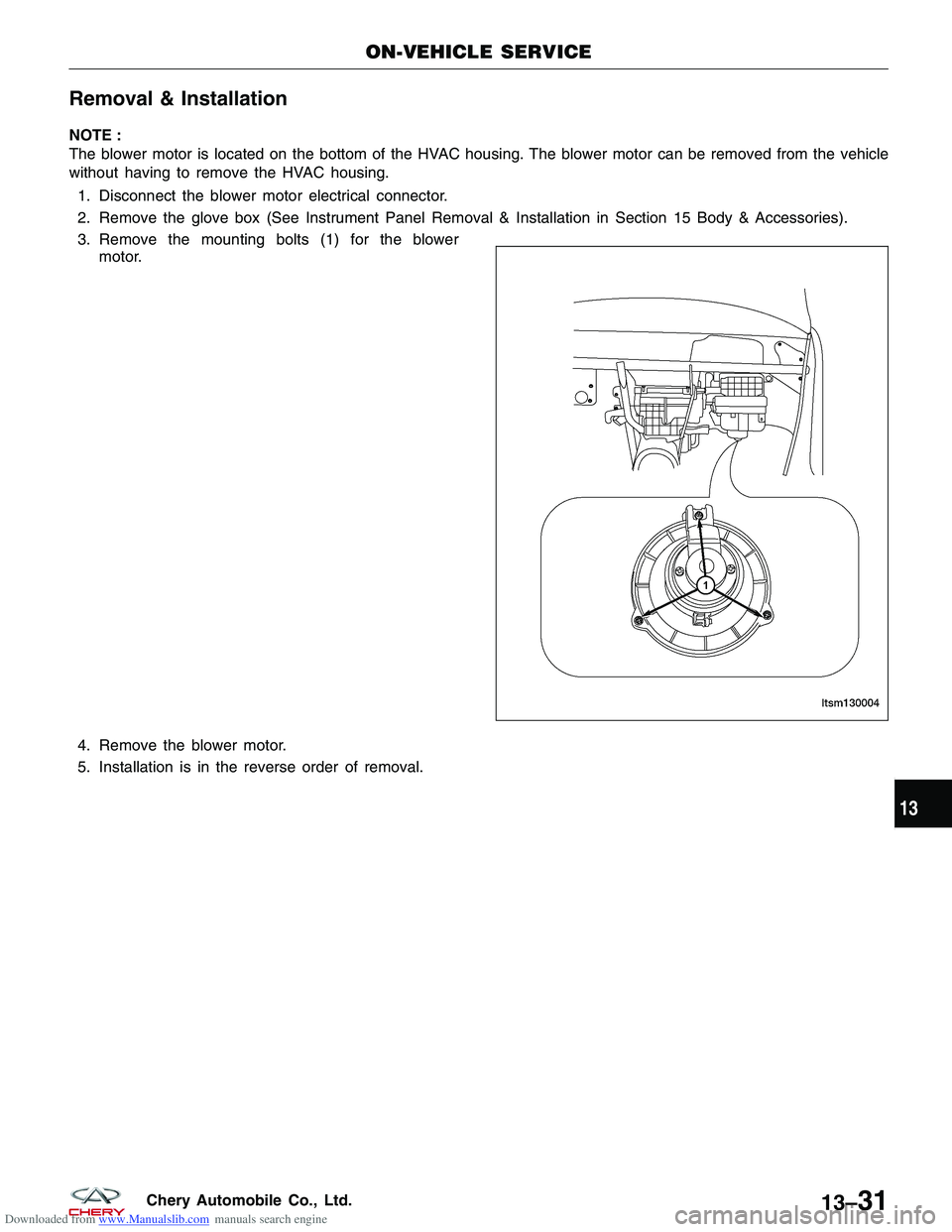
Downloaded from www.Manualslib.com manuals search engine Removal & Installation
NOTE :
The blower motor is located on the bottom of the HVAC housing. The blower motor can be removed from the vehicle
without having to remove the HVAC housing.1. Disconnect the blower motor electrical connector.
2. Remove the glove box (See Instrument Panel Removal & Installation in Section 15 Body & Accessories).
3. Remove the mounting bolts (1) for the blower motor.
4. Remove the blower motor.
5. Installation is in the reverse order of removal.
ON-VEHICLE SERVICE
LTSM130004
13
13–31Chery Automobile Co., Ltd.
Page 1514 of 1903
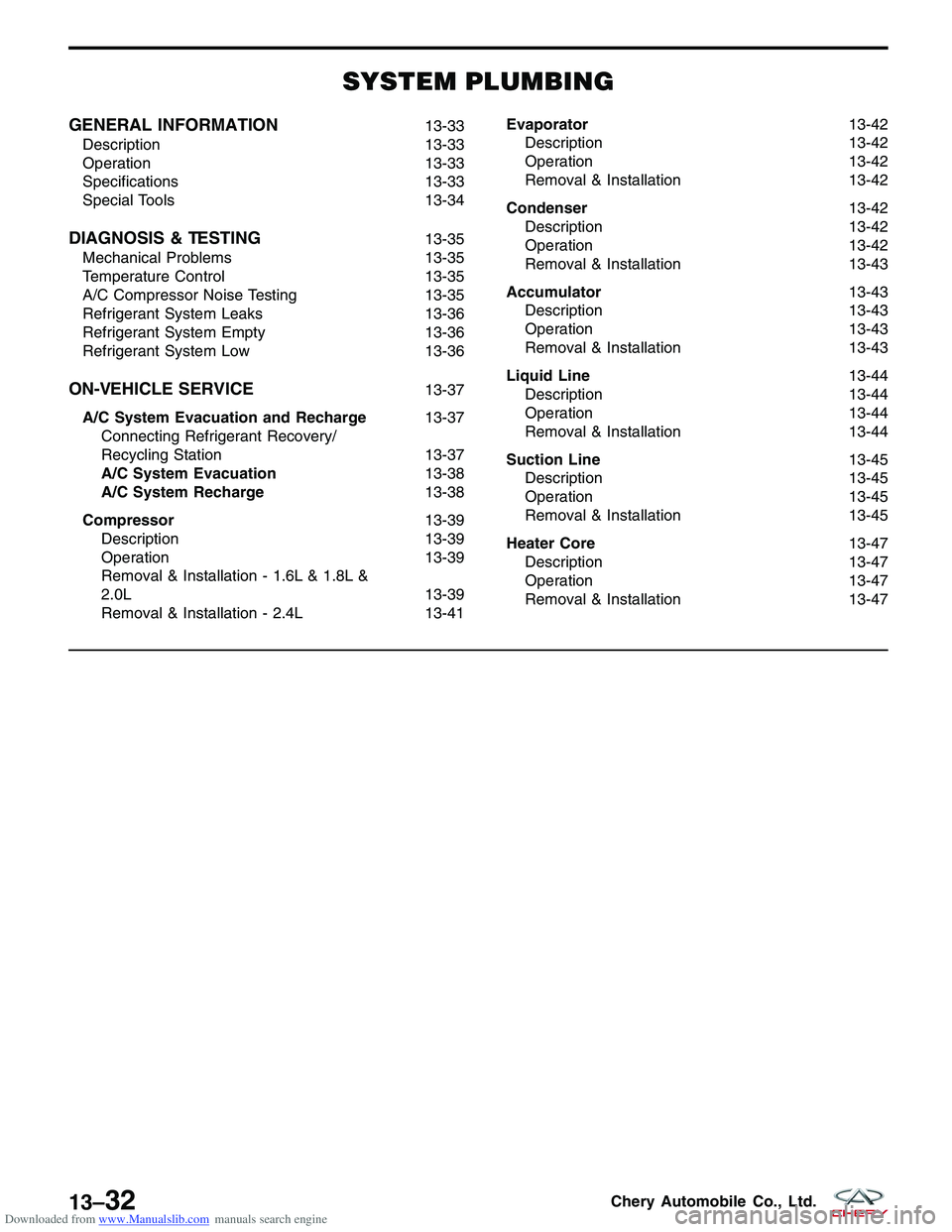
Downloaded from www.Manualslib.com manuals search engine SYSTEM PLUMBING
GENERAL INFORMATION13-33
Description 13-33
Operation 13-33
Specifications 13-33
Special Tools 13-34
DIAGNOSIS & TESTING13-35
Mechanical Problems 13-35
Temperature Control 13-35
A/C Compressor Noise Testing 13-35
Refrigerant System Leaks 13-36
Refrigerant System Empty 13-36
Refrigerant System Low 13-36
ON-VEHICLE SERVICE13-37
A/C System Evacuation and Recharge 13-37
Connecting Refrigerant Recovery/
Recycling Station 13-37
A/C System Evacuation 13-38
A/C System Recharge 13-38
Compressor 13-39
Description 13-39
Operation 13-39
Removal & Installation - 1.6L & 1.8L &
2.0L 13-39
Removal & Installation - 2.4L 13-41 Evaporator
13-42
Description 13-42
Operation 13-42
Removal & Installation 13-42
Condenser 13-42
Description 13-42
Operation 13-42
Removal & Installation 13-43
Accumulator 13-43
Description 13-43
Operation 13-43
Removal & Installation 13-43
Liquid Line 13-44
Description 13-44
Operation 13-44
Removal & Installation 13-44
Suction Line 13-45
Description 13-45
Operation 13-45
Removal & Installation 13-45
Heater Core 13-47
Description 13-47
Operation 13-47
Removal & Installation 13-47
13–32Chery Automobile Co., Ltd.
Page 1515 of 1903
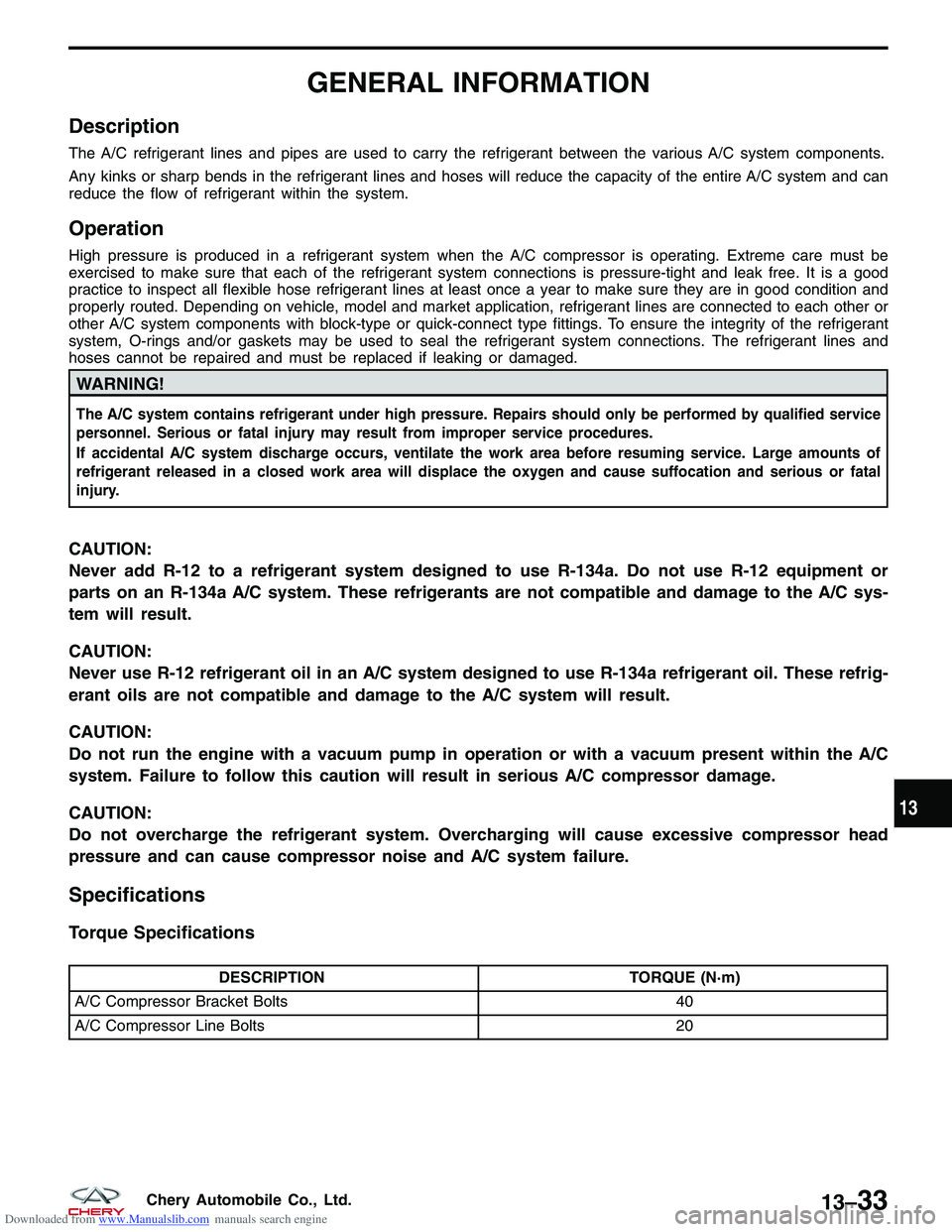
Downloaded from www.Manualslib.com manuals search engine GENERAL INFORMATION
Description
The A/C refrigerant lines and pipes are used to carry the refrigerant between the various A/C system components.
Any kinks or sharp bends in the refrigerant lines and hoses will reduce the capacity of the entire A/C system and can
reduce the flow of refrigerant within the system.
Operation
High pressure is produced in a refrigerant system when the A/C compressor is operating. Extreme care must be
exercised to make sure that each of the refrigerant system connections is pressure-tight and leak free. It is a good
practice to inspect all flexible hose refrigerant lines at least once a year to make sure they are in good condition and
properly routed. Depending on vehicle, model and market application, refrigerant lines are connected to each other or
other A/C system components with block-type or quick-connect type fittings. To ensure the integrity of the refrigerant
system, O-rings and/or gaskets may be used to seal the refrigerant system connections. The refrigerant lines and
hoses cannot be repaired and must be replaced if leaking or damaged.
WARNING!
The A/C system contains refrigerant under high pressure. Repairs should only be performed by qualified service
personnel. Serious or fatal injury may result from improper service procedures.
If accidental A/C system discharge occurs, ventilate the work area before resuming service. Large amounts of
refrigerant released in a closed work area will displace the oxygen and cause suffocation and serious or fatal
injury.
CAUTION:
Never add R-12 to a refrigerant system designed to use R-134a. Do not use R-12 equipment or
parts on an R-134a A/C system. These refrigerants are not compatible and damage to the A/C sys-
tem will result.
CAUTION:
Never use R-12 refrigerant oil in an A/C system designed to use R-134a refrigerant oil. These refrig-
erant oils are not compatible and damage to the A/C system will result.
CAUTION:
Do not run the engine with a vacuum pump in operation or with a vacuum present within the A/C
system. Failure to follow this caution will result in serious A/C compressor damage.
CAUTION:
Do not overcharge the refrigerant system. Overcharging will cause excessive compressor head
pressure and can cause compressor noise and A/C system failure.
Specifications
Torque Specifications
DESCRIPTIONTORQUE (N·m)
A/C Compressor Bracket Bolts 40
A/C Compressor Line Bolts 20
13
13–33Chery Automobile Co., Ltd.
Page 1516 of 1903
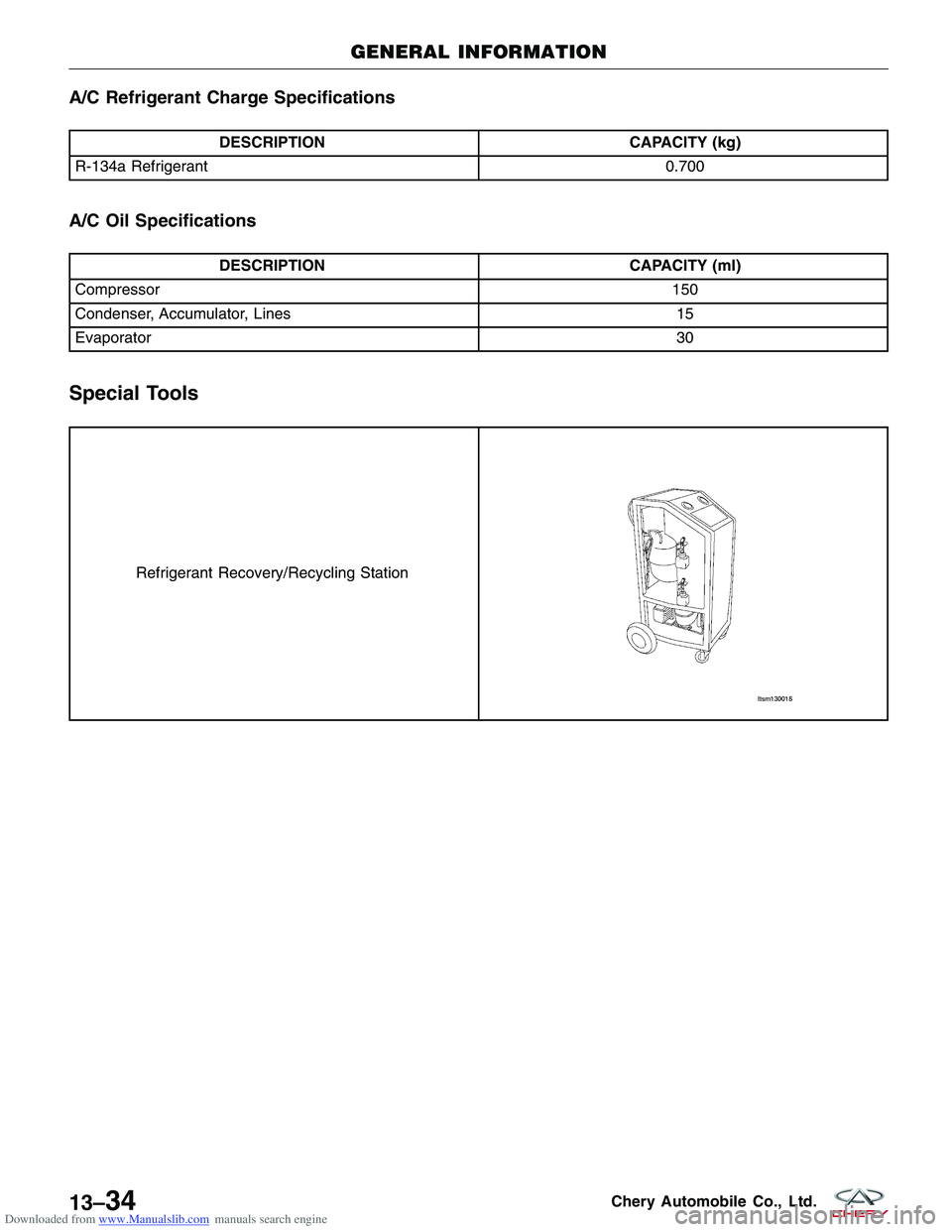
Downloaded from www.Manualslib.com manuals search engine A/C Refrigerant Charge Specifications
DESCRIPTIONCAPACITY (kg)
R-134a Refrigerant 0.700
A/C Oil Specifications
DESCRIPTIONCAPACITY (ml)
Compressor 150
Condenser, Accumulator, Lines 15
Evaporator 30
Special Tools
Refrigerant Recovery/Recycling Station
GENERAL INFORMATION
13–34Chery Automobile Co., Ltd.
Page 1517 of 1903
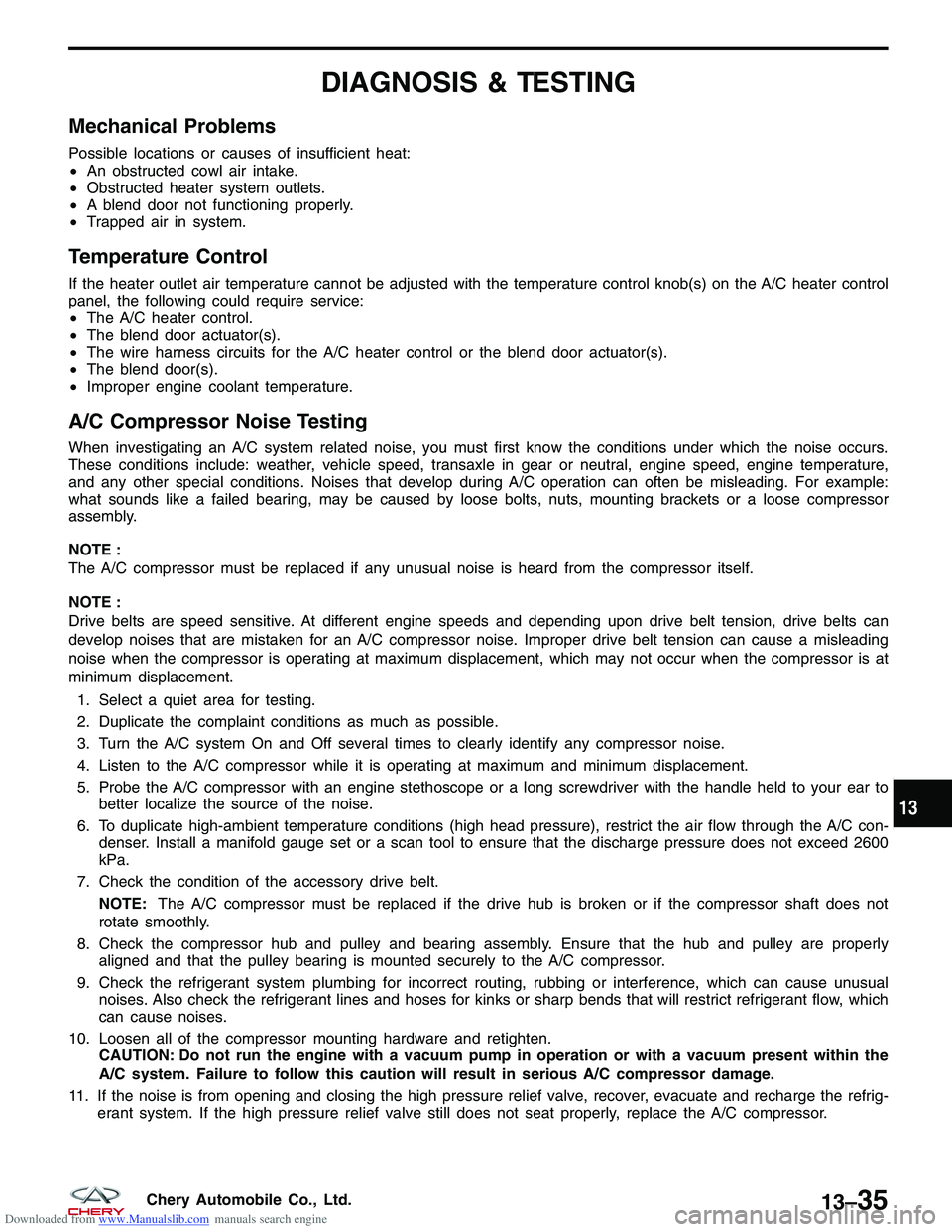
Downloaded from www.Manualslib.com manuals search engine DIAGNOSIS & TESTING
Mechanical Problems
Possible locations or causes of insufficient heat:
•An obstructed cowl air intake.
• Obstructed heater system outlets.
• A blend door not functioning properly.
• Trapped air in system.
Temperature Control
If the heater outlet air temperature cannot be adjusted with the temperature control knob(s) on the A/C heater control
panel, the following could require service:
•The A/C heater control.
• The blend door actuator(s).
• The wire harness circuits for the A/C heater control or the blend door actuator(s).
• The blend door(s).
• Improper engine coolant temperature.
A/C Compressor Noise Testing
When investigating an A/C system related noise, you must first know the conditions under which the noise occurs.
These conditions include: weather, vehicle speed, transaxle in gear or neutral, engine speed, engine temperature,
and any other special conditions. Noises that develop during A/C operation can often be misleading. For example:
what sounds like a failed bearing, may be caused by loose bolts, nuts, mounting brackets or a loose compressor
assembly.
NOTE :
The A/C compressor must be replaced if any unusual noise is heard from the compressor itself.
NOTE :
Drive belts are speed sensitive. At different engine speeds and depending upon drive belt tension, drive belts can
develop noises that are mistaken for an A/C compressor noise. Improper drive belt tension can cause a misleading
noise when the compressor is operating at maximum displacement, which may not occur when the compressor is at
minimum displacement.
1. Select a quiet area for testing.
2. Duplicate the complaint conditions as much as possible.
3. Turn the A/C system On and Off several times to clearly identify any compressor noise.
4. Listen to the A/C compressor while it is operating at maximum and minimum displacement.
5. Probe the A/C compressor with an engine stethoscope or a long screwdriver with the handle held to your ear to better localize the source of the noise.
6. To duplicate high-ambient temperature conditions (high head pressure), restrict the air flow through the A/C con- denser. Install a manifold gauge set or a scan tool to ensure that the discharge pressure does not exceed 2600
kPa.
7. Check the condition of the accessory drive belt. NOTE: The A/C compressor must be replaced if the drive hub is broken or if the compressor shaft does not
rotate smoothly.
8. Check the compressor hub and pulley and bearing assembly. Ensure that the hub and pulley are properly aligned and that the pulley bearing is mounted securely to the A/C compressor.
9. Check the refrigerant system plumbing for incorrect routing, rubbing or interference, which can cause unusual noises. Also check the refrigerant lines and hoses for kinks or sharp bends that will restrict refrigerant flow, which
can cause noises.
10. Loosen all of the compressor mounting hardware and retighten. CAUTION: Do not run the engine with a vacuum pump in operation or with a vacuum present within the
A/C system. Failure to follow this caution will result in serious A/C compressor damage.
11. If the noise is from opening and closing the high pressure relief valve, recover, evacuate and recharge the refrig- erant system. If the high pressure relief valve still does not seat properly, replace the A/C compressor.
13
13–35Chery Automobile Co., Ltd.
Page 1518 of 1903
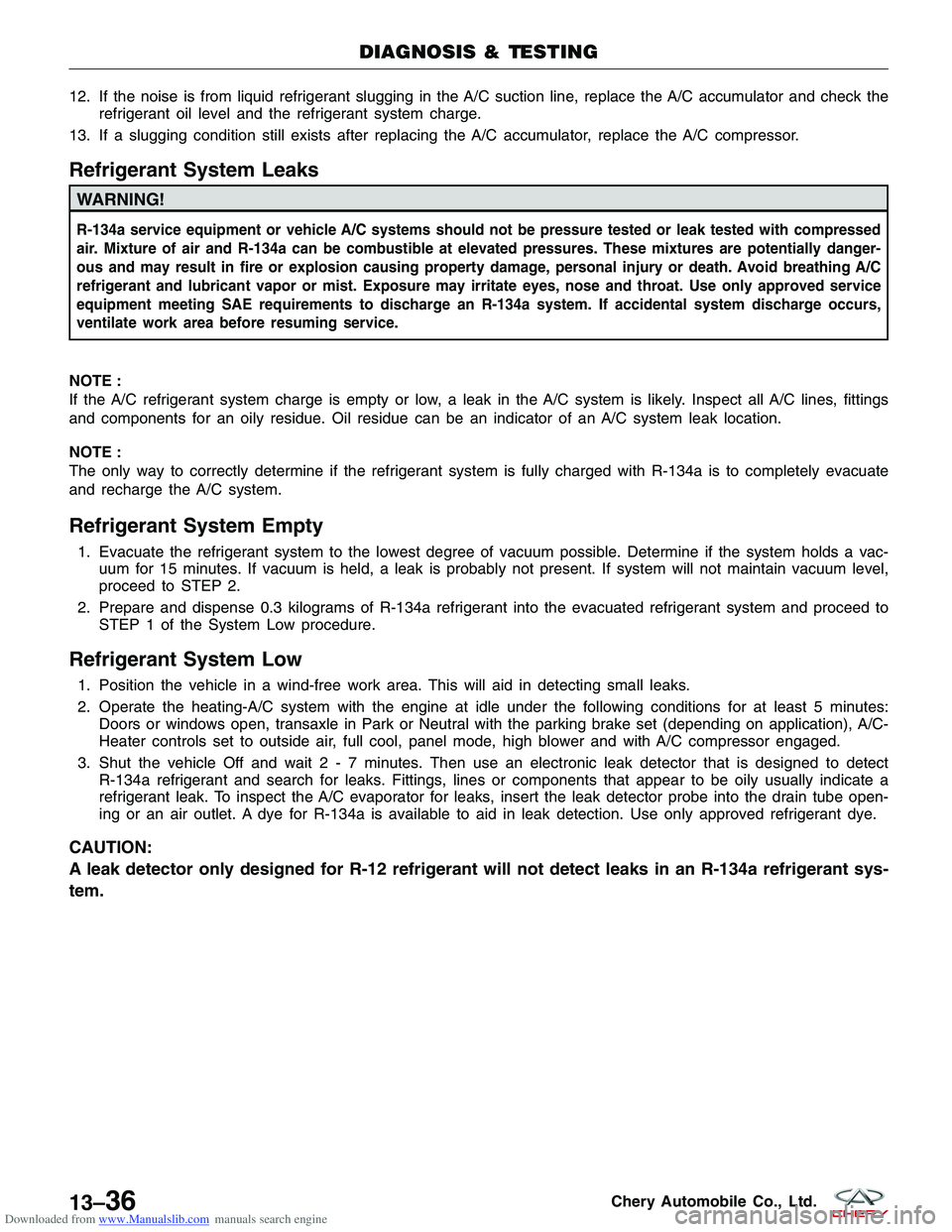
Downloaded from www.Manualslib.com manuals search engine 12. If the noise is from liquid refrigerant slugging in the A/C suction line, replace the A/C accumulator and check therefrigerant oil level and the refrigerant system charge.
13. If a slugging condition still exists after replacing the A/C accumulator, replace the A/C compressor.
Refrigerant System Leaks
WARNING!
R-134a service equipment or vehicle A/C systems should not be pressure tested or leak tested with compressed
air. Mixture of air and R-134a can be combustible at elevated pressures. These mixtures are potentially danger-
ous and may result in fire or explosion causing property damage, personal injury or death. Avoid breathing A/C
refrigerant and lubricant vapor or mist. Exposure may irritate eyes, nose and throat. Use only approved service
equipment meeting SAE requirements to discharge an R-134a system. If accidental system discharge occurs,
ventilate work area before resuming service.
NOTE :
If the A/C refrigerant system charge is empty or low, a leak in the A/C system is likely. Inspect all A/C lines, fittings
and components for an oily residue. Oil residue can be an indicator of an A/C system leak location.
NOTE :
The only way to correctly determine if the refrigerant system is fully charged with R-134a is to completely evacuate
and recharge the A/C system.
Refrigerant System Empty
1. Evacuate the refrigerant system to the lowest degree of vacuum possible. Determine if the system holds a vac- uum for 15 minutes. If vacuum is held, a leak is probably not present. If system will not maintain vacuum level,
proceed to STEP 2.
2. Prepare and dispense 0.3 kilograms of R-134a refrigerant into the evacuated refrigerant system and proceed to STEP 1 of the System Low procedure.
Refrigerant System Low
1. Position the vehicle in a wind-free work area. This will aid in detecting small leaks.
2. Operate the heating-A/C system with the engine at idle under the following conditions for at least 5 minutes:Doors or windows open, transaxle in Park or Neutral with the parking brake set (depending on application), A/C-
Heater controls set to outside air, full cool, panel mode, high blower and with A/C compressor engaged.
3. Shut the vehicle Off and wait2-7minutes. Then use an electronic leak detector that is designed to detect R-134a refrigerant and search for leaks. Fittings, lines or components that appear to be oily usually indicate a
refrigerant leak. To inspect the A/C evaporator for leaks, insert the leak detector probe into the drain tube open-
ing or an air outlet. A dye for R-134a is available to aid in leak detection. Use only approved refrigerant dye.
CAUTION:
A leak detector only designed for R-12 refrigerant will not detect leaks in an R-134a refrigerant sys-
tem.
DIAGNOSIS & TESTING
13–36Chery Automobile Co., Ltd.
Page 1519 of 1903
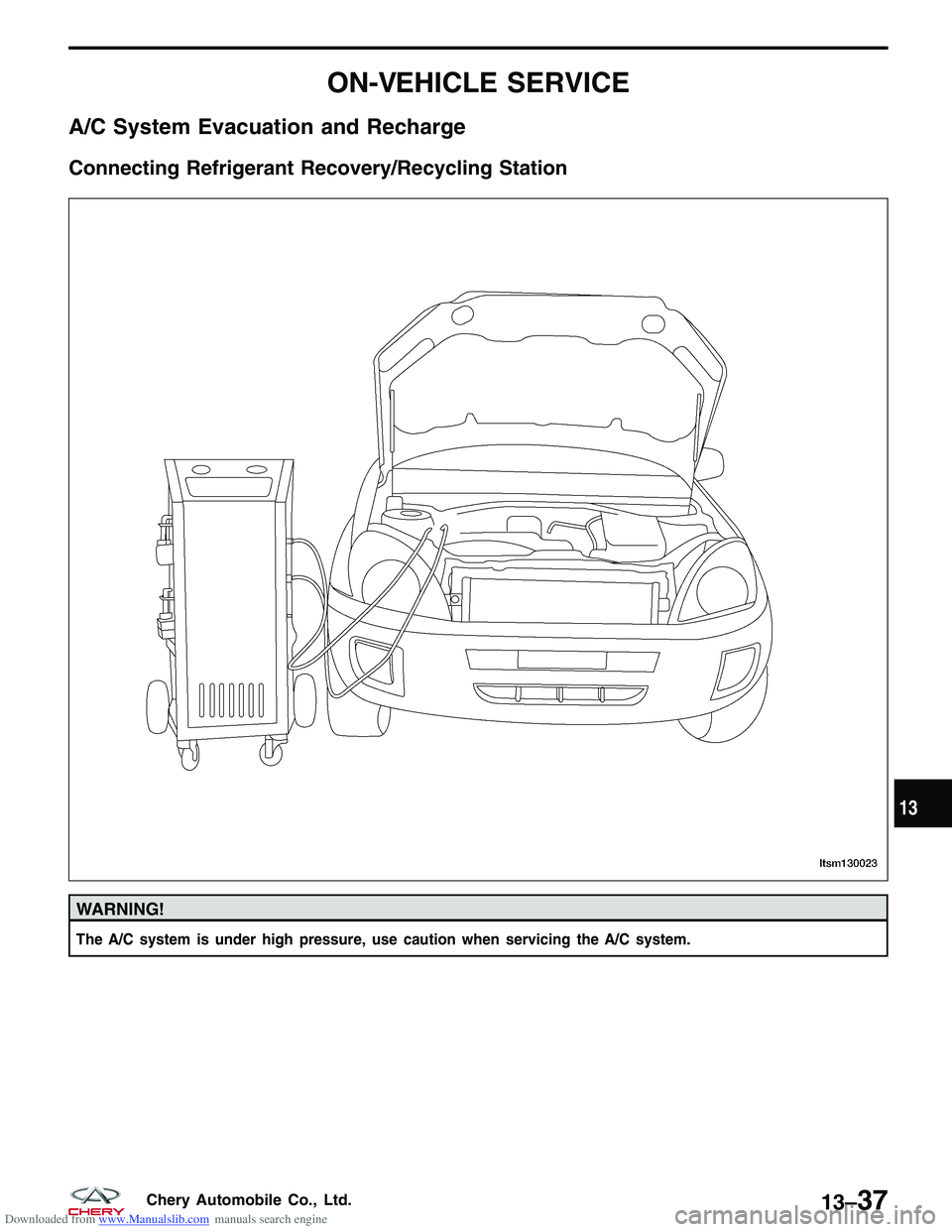
Downloaded from www.Manualslib.com manuals search engine ON-VEHICLE SERVICE
A/C System Evacuation and Recharge
Connecting Refrigerant Recovery/Recycling Station
WARNING!
The A/C system is under high pressure, use caution when servicing the A/C system.
LTSM130023
13
13–37Chery Automobile Co., Ltd.
Page 1520 of 1903
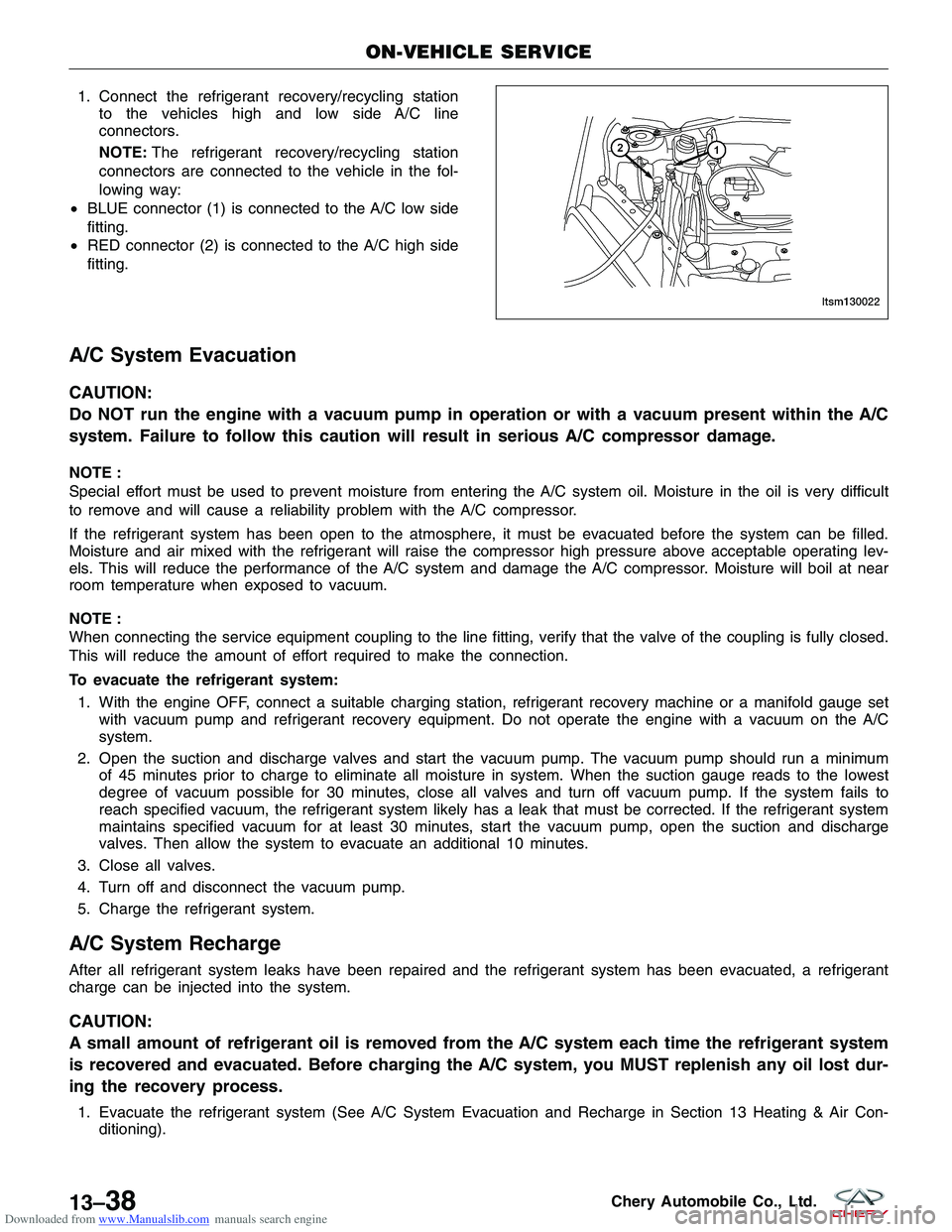
Downloaded from www.Manualslib.com manuals search engine 1. Connect the refrigerant recovery/recycling stationto the vehicles high and low side A/C line
connectors.
NOTE: The refrigerant recovery/recycling station
connectors are connected to the vehicle in the fol-
lowing way:
• BLUE connector (1) is connected to the A/C low side
fitting.
• RED connector (2) is connected to the A/C high side
fitting.
A/C System Evacuation
CAUTION:
Do NOT run the engine with a vacuum pump in operation or with a vacuum present within the A/C
system. Failure to follow this caution will result in serious A/C compressor damage.
NOTE :
Special effort must be used to prevent moisture from entering the A/C system oil. Moisture in the oil is very difficult
to remove and will cause a reliability problem with the A/C compressor.
If the refrigerant system has been open to the atmosphere, it must be evacuated before the system can be filled.
Moisture and air mixed with the refrigerant will raise the compressor high pressure above acceptable operating lev-
els. This will reduce the performance of the A/C system and damage the A/C compressor. Moisture will boil at near
room temperature when exposed to vacuum.
NOTE :
When connecting the service equipment coupling to the line fitting, verify that the valve of the coupling is fully closed.
This will reduce the amount of effort required to make the connection.
To evacuate the refrigerant system:
1. With the engine OFF, connect a suitable charging station, refrigerant recovery machine or a manifold gauge set with vacuum pump and refrigerant recovery equipment. Do not operate the engine with a vacuum on the A/C
system.
2. Open the suction and discharge valves and start the vacuum pump. The vacuum pump should run a minimum of 45 minutes prior to charge to eliminate all moisture in system. When the suction gauge reads to the lowest
degree of vacuum possible for 30 minutes, close all valves and turn off vacuum pump. If the system fails to
reach specified vacuum, the refrigerant system likely has a leak that must be corrected. If the refrigerant system
maintains specified vacuum for at least 30 minutes, start the vacuum pump, open the suction and discharge
valves. Then allow the system to evacuate an additional 10 minutes.
3. Close all valves.
4. Turn off and disconnect the vacuum pump.
5. Charge the refrigerant system.
A/C System Recharge
After all refrigerant system leaks have been repaired and the refrigerant system has been evacuated, a refrigerant
charge can be injected into the system.
CAUTION:
A small amount of refrigerant oil is removed from the A/C system each time the refrigerant system
is recovered and evacuated. Before charging the A/C system, you MUST replenish any oil lost dur-
ing the recovery process.
1. Evacuate the refrigerant system (See A/C System Evacuation and Recharge in Section 13 Heating & Air Con- ditioning).
ON-VEHICLE SERVICE
LTSM130022
13–38Chery Automobile Co., Ltd.